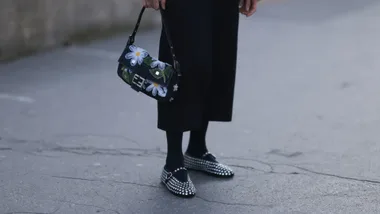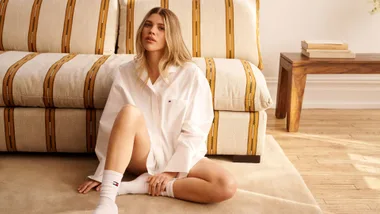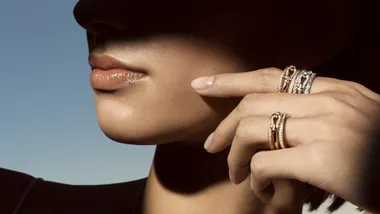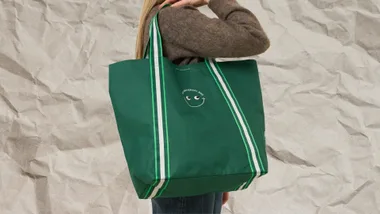Think of ballet, and what comes to mind? Frothy tulle, satin ribbons and cute leotards in hues of pale pink, white and black? What about dark-purple bruises, oozing blisters and bandaged, bloody toes?
The latter list may not be quite so instagrammable, but they are some of the less aesthetic realities of wearing those pretty pink pointe shoes for hours on end.
Times have changed since balletomania (no hashtag) first took flight in the 1920s and ’30s, thanks largely to the Ballets Russes in Paris, whose designs influenced he likes of Jeanne Lanvin, Madeleine Vionnet and Coco Chanel.
Today’s #balletcore trend arrives at a time when fashion is having to do a lot of reckoning in all sorts of areas — from inclusivity and diversity to sustainability — and when the industry is being called out for bad behaviour on any and more of these fronts.
For those who never had the opportunity to study ballet (or gave up the lessons early on), it’s easy to see the appeal of balletcore. It can be pretty and elegant, with layers of gossamer and pastel hues bringing to mind childhood fantasies of femininity. It can also be comfortable, with ballet flats and wrap cardigans, bodysuits and slouchy track pants conjuring up classes and rehearsals. Indeed, off-duty dancer has usurped off-duty model when it comes to casual style.
We can safely bow to Miu Miu for the latest obsession with balletcore, thanks to its blunt-toed ballet flats that caused a frenzy in its autumn 2022 collection. but there are plenty of other designers who regularly pirouette in the spotlight. Simone Rocha and Molly Goddard’s tulle confections owe a debt to the dancer, and Giambattista Valli’s signature heavily layered tulle gowns are a tutu fever-dream.
Dior’s creative director Maria Grazia Chiuri regularly nods to the ballet, often in graceful, featherlight pieces, just as the house’s founder once did with his corseted bodices and full skirts reminiscent of classical ballet’s corseted tutus. (In fact, prima ballerina Margot Fonteyn was a devotee of Dior until his death).
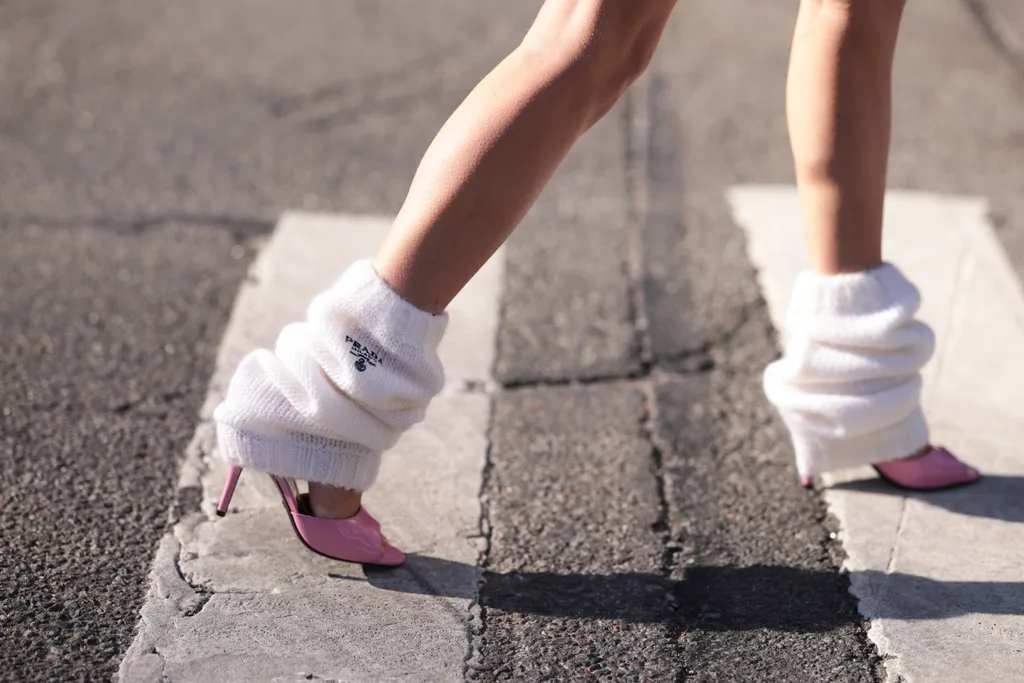
The symbiotic relationship between fashion and ballet has been explored recently in not one but two exhibitions. In 2019, the Kunstmuseum in The Hague held “Let’s Dance!”, followed in 2020 by “Ballerina: Fashion’s Modern Muse” at the Fashion Institute of Technology in New York.
And popular culture touchpoints reignite the relationship on a regular basis. As far back as 1948, ballerina Moira Shearer starred as an ill-fated dancer in The Red Shoes, bringing ballet styles into vogue. The TV series Fame in the 1980s and the film Center Stage in 2000 both showed life behind the scenes for students aspiring to a career in dance, and with them came a more casual take on ballet fashion.
More recently, the 2010 film Black Swan took a darker psychological turn on the subject, while also spawning a thousand “get the look” Pinterest pages for Natalie Portman’s prima ballerina Nina Sayers, with feathered accessories taking first position. (Fashion darlings Kate and Laura Mulleavy of Rodarte designed the film’s costumes.)
Kayla Marci, womenswear analyst for global retail analysts EDITED, believes that sales data “establishes that the delicate, feminine aesthetic has struck a chord with consumers”.
“Products with more on-the-nose references to balletcore generated the highest increase in sales activity since the start of 2023 compared to the year prior,” Marci tells marie claire.
To that end, she says the number of tulle dresses and skirts selling out online has increased by 933 per cent in Australia (and 82 per cent in the US/UK); sell-outs of arm and leg warmers rose 100 per cent in Australia (and 164 per cent in the US/UK), year on year.
“Hyperfemininity remained a driving force at the latest runway shows, securing balletcore’s status as a coveted trend for fall 2023-24,” adds Marci. “Bubble-gum pinks and pastels continued to crop up in collections. Voluminous sleeves and skirts were championed at Molly Goddard and Carolina Herrera, and ribbons and legwarmers were displayed at Simone Rocha — all feeding into balletcore. Additionally, the fitted cardigans showcased at Miu Miu will provide a fresh silhouette update for brands next season.”
So, if ballet-inspired fashion is so appealing to consumers, and therefore a regular inspiration for designers, wherein lies the rub? In short, with the use of models posing as ballerinas in magazine shoots and brand campaigns.
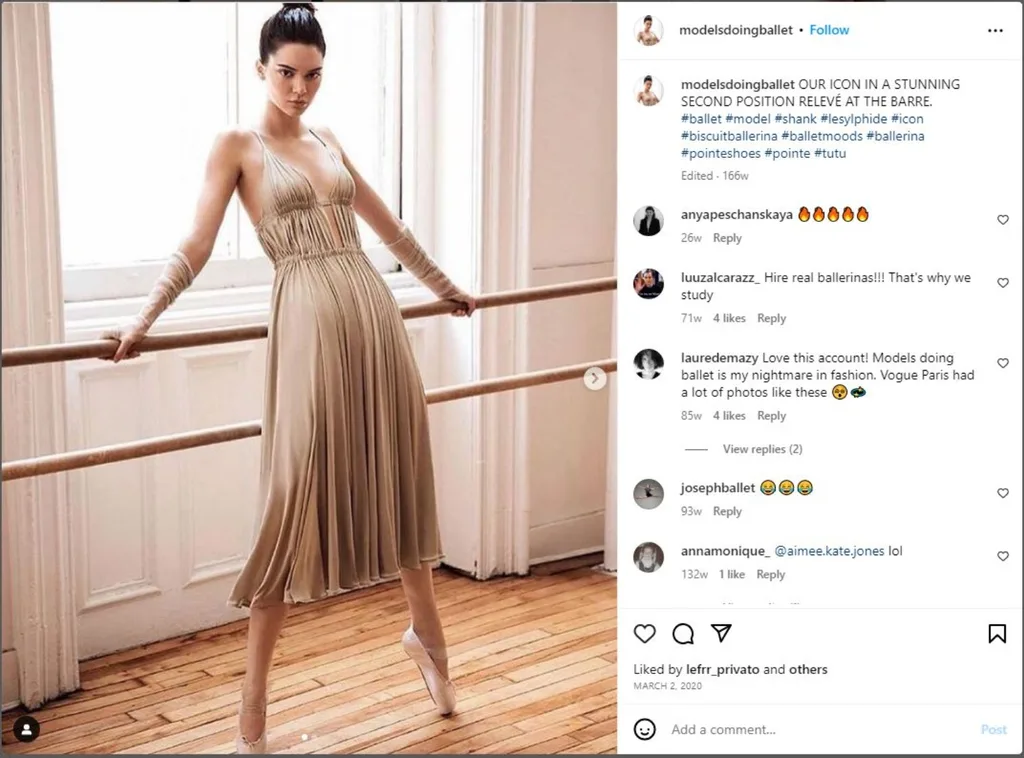
Three years ago, US-based dancers and dance teachers Katie Malia and Suzanne Jolie started the Instagram account @modelsdoingballet. They had for years amused each other with photos of models pretending to be dancers. But it was a shoot with Kendall Jenner for Spanish Vogue that finally tipped them into social media action, wishing to share their delight with a few others.
The pair call Jenner their “north star” — she is the only person the account follows. It obviously struck a chord: the account now has more than 90,000 followers.
“Fashion is fun, and I don’t think there’s anything wrong with balletcore per se, it’s just more about ballet not being taken seriously,” Malia tells marie claire. “Brands have to know that if they’re going to hire non-dancers for dance-inspired shoots then they’re putting themselves at risk of dancers calling them out.”
She says the main outcome they are hoping for is “to educate brands about showing respect to dancers by providing job opportunities, fair compensation and representation”.
Jolie adds that among the many misrepresentations of ballet portrayed by models, “You can always tell immediately by the hands if someone isn’t trained. [It’s a] dead giveaway.”
Malia understands that brands want the big names — such as Jenner, and Bella and Gigi Hadid, who have all donned pointe shoes — to front shoots and campaigns, but says it’s “a lack of knowledge and straight-up laziness on their part” that they don’t consider dancers to tell their stories.
“I think one of the factors is celebrity status, and ballet dancers were so niche that unless you were Baryshnikov guest-starring on Sex and the City, dancers weren’t famous enough to put on the runway or in a campaign,” she says. “Ballet is different [from] sport. It’s art and athleticism combined, and it’s time dancers are treated as such.”

It’s a sentiment echoed by many in the industry. Claire Voss recently retired as demi-soloist with the West Australian Ballet, and has founded the movement consultancy business VossMoves in Perth. She feels for the models being put in these (unpractised) positions by those behind the camera. “Models are incredible but they’re not always very aware of their movements,” says Voss. “If you’re going to go into something as hard and specific as ballet, you need to actually know and understand it, because it takes us years and years of practice to perfect those lines.”
Belle Urwin is a member of the corps de ballet of The Australian Ballet, and while she finds the Instagram account and attempts by the fashion industry to co-opt what dancers do humorous, she would also like to see change.
“It’s entertaining to see these models wearing balletcore pointe shoes,” says Urwin, “but sometimes it’s frustrating seeing models modelling balletcore. As fun as it is to play dress-up, it would be great to have actual ballet dancers represent their own aesthetic.”
Aside from models not having the skills of a ballerina, undoubtedly the biggest faux pas on fashion shoots comes with the use of pointe shoes — even just from a visual perspective, let alone the potential for injury. A scroll through the @modelsdoingballet Instagram account throws up all manner of pointe shoe indiscretions: gaping sides, squashed backs, loose ribbons, ribbons tied all the way up the calf or over socks, toes almost bursting through the front of the shoe.
And, alarmingly, models are often photographed attempting to pose en pointe, a practice that without the correct training can have disastrous consequences, even more so when the shoes are not worn correctly. “It takes huge amounts of work and preparation,” explains Voss. “If you go on pointe shoes the wrong way you could twist ligaments or fracture something.”

There is no doubting the appeal of balletcore to those of us who will never be able to jeté across a stage or attempt a grand plié without pulling a muscle.
“Whenever someone learns I am a ballet dancer and teacher, many times their first reaction is to say, ‘I used to take ballet when I was little,’” says Jolie. “And then they proceed to tell me how much they miss it and wish they hadn’t quit. I think for some people it goes pretty deep and a pair of ballet flats can bring a little of that lost joy.”
Urwin also gets it. “It’s fun to see people adopting balletcore to feel beautiful,” she says. “The balletcore aesthetic is a very dainty, lighthearted girlie look, and although we try to portray that aesthetic, it’s definitely not how we feel.”
Urwin is one of many dancers who have taken to TikTok to show the reality of ballet, which has plenty of gritty amid the pretty. Given that #ballet has had more than 14 billion views on the platform and #balletcore has more than 700 million, there is a clear appetite for both the reality and the fantasy.
“The good thing about TikTok is it’s a little more rustic and natural, [while] Instagram is quite pretty,” says Urwin. “People love to see that we have our personalities and they love our behind-the-scenes videos – everything from how pointe shoes should be worn to a bunch of tutus lying on the floor.”
As to its portrayal by the fashion industry, there are flickers of hope. Malia and Jolie cite a number of brands doing the right thing and hiring actual dancers to portray a balletic mood. These include Nike, Michael Kors, Iris van Herpen, Under Armour and Emilia Wickstead.
“We even had an agent from a very prominent modelling agency in New York reach out and consult us about the special division he is creating,” says Jolie. “The division is just for actual dancers who also model. We are watching change happen in real time and it’s so fulfilling. It’s exactly what we hoped to do.”
And perhaps it won’t be too long before fashion and ballet reunite in that perfect pas de deux once more. With perfectly tied pointe shoes, of course.
This story originally appeared in the July issue of marie claire Australia.


